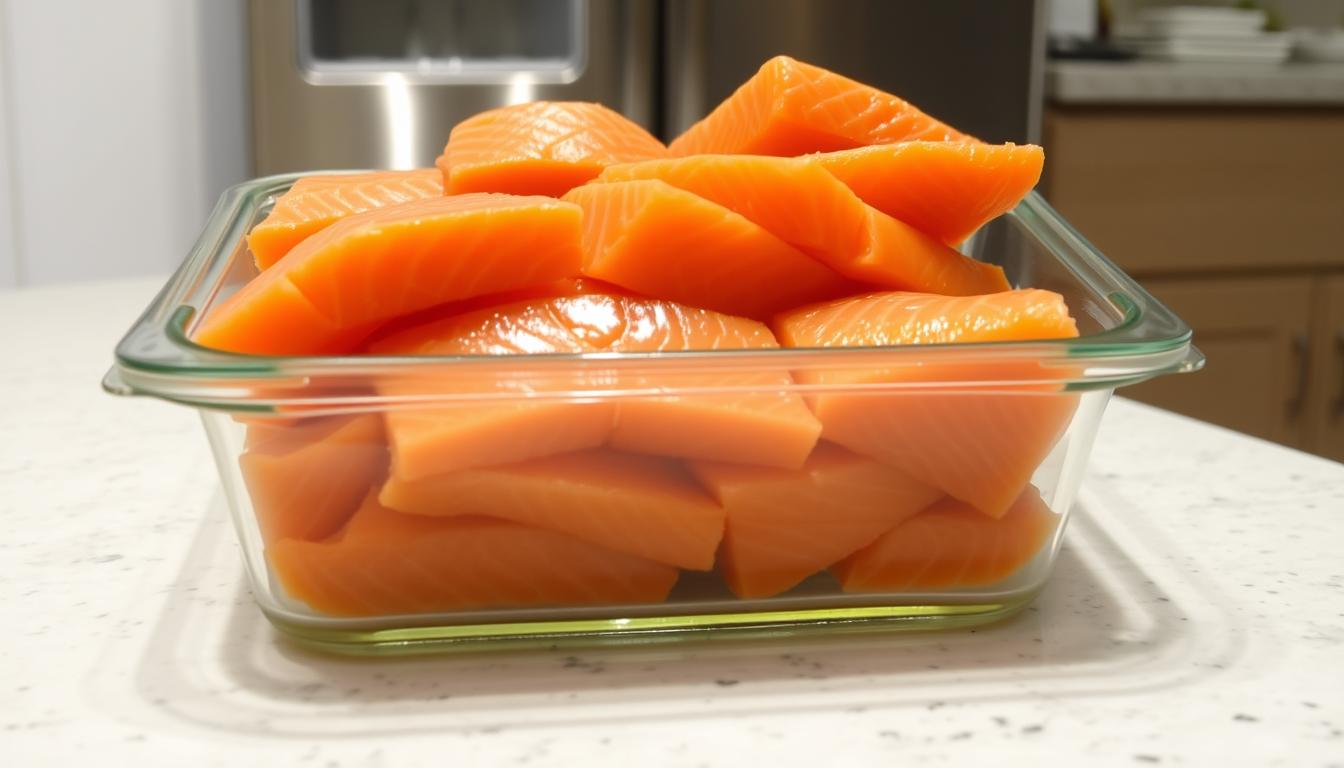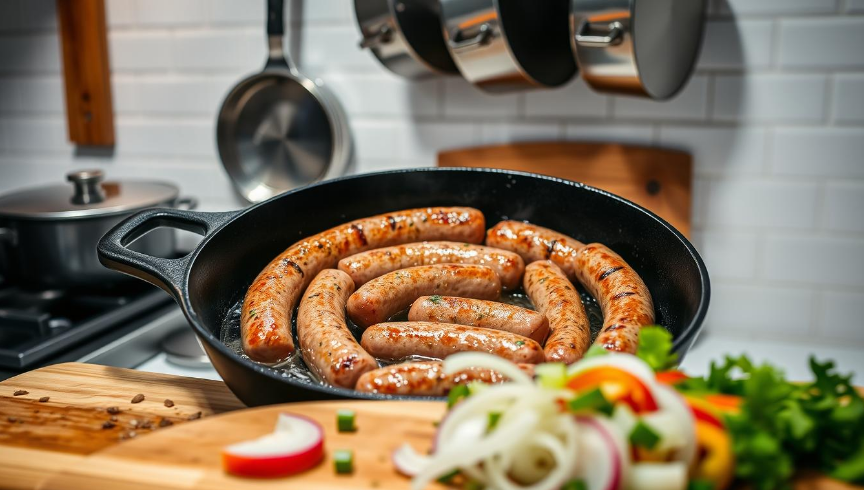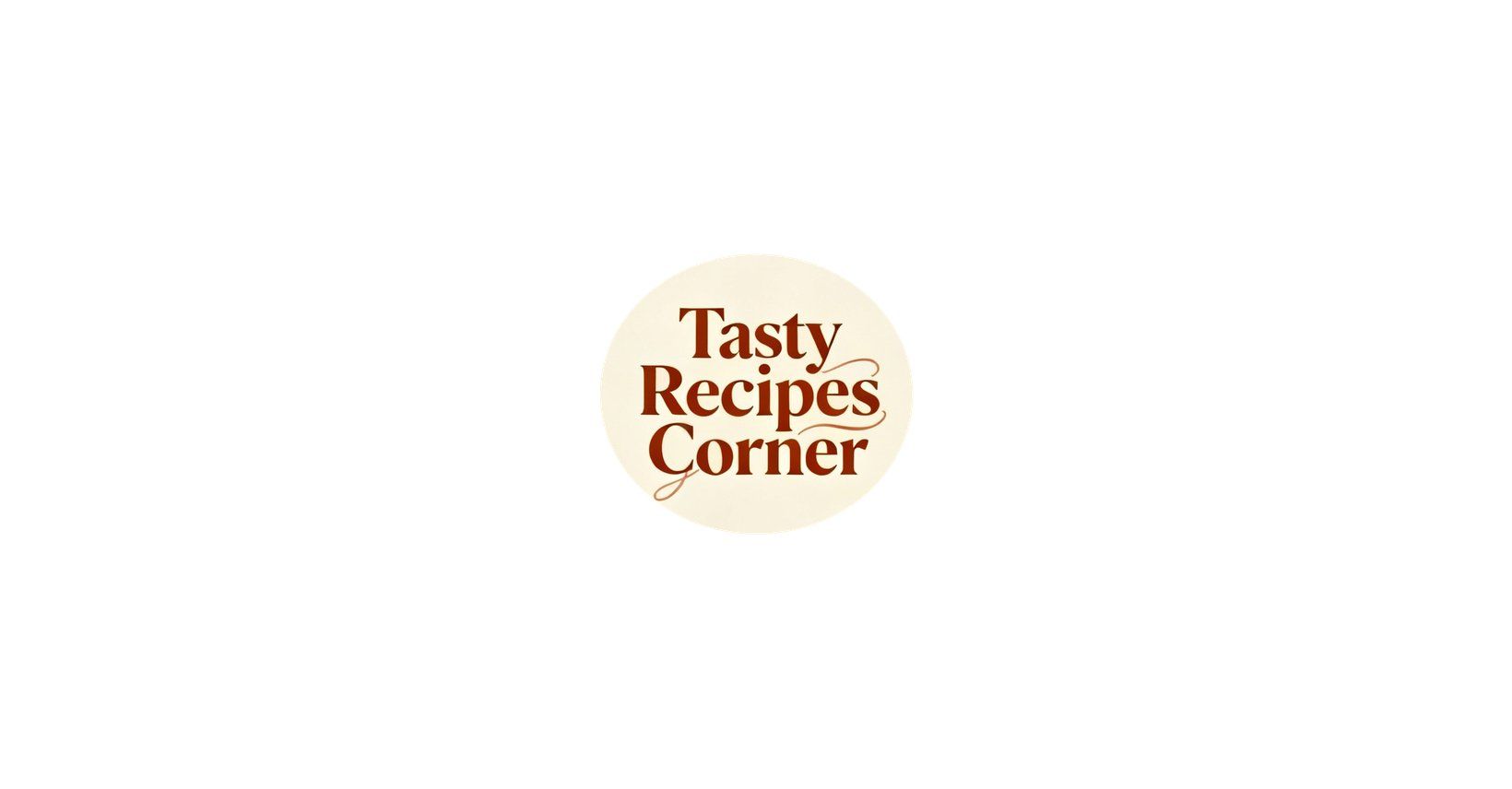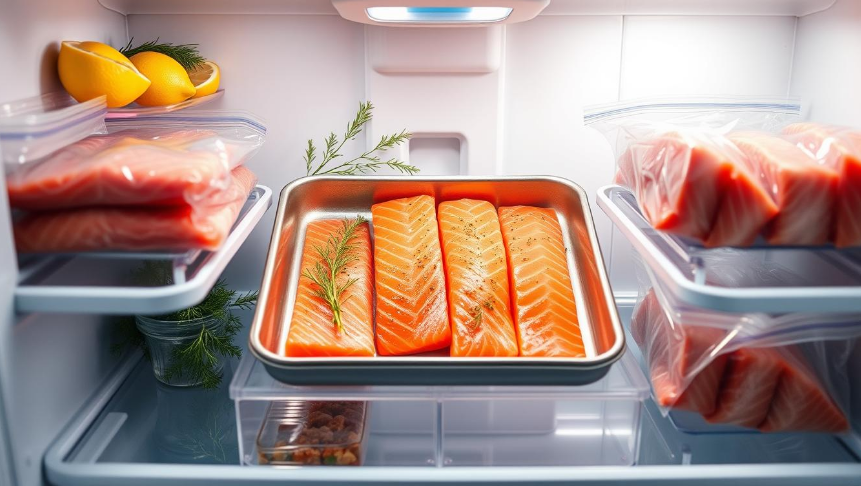How long is cooked salmon good for
Table of Contents
You’ve invested in a delicious piece of cooked salmon, and now you’re wondering how to keep it fresh for as long as possible. Proper storage is crucial to maintaining its quality and safety.
When stored correctly, cooked salmon can remain safe to eat for several days. However, its shelf life depends on various factors, including storage conditions and handling practices. To enjoy your cooked salmon at its best, it’s essential to understand the guidelines for storing it.
Key Takeaways
- Cooked salmon storage guidelines to maintain freshness
- Factors affecting the shelf life of cooked salmon
- Safe handling practices for cooked salmon
- Tips for maximizing the storage life of cooked salmon
- Signs of spoilage in cooked salmon
The Basics of Cooked Salmon Storage
Knowing how to store cooked salmon is key to keeping it fresh and safe. It’s important to follow food safety rules and handle salmon carefully.
Food Safety Principles for Fish
Food safety for fish like salmon focuses on avoiding contamination and keeping the right temperature. Always store cooked salmon in a covered, airtight container. This helps prevent cross-contamination and keeps it cold.
Make sure to label the container with the date it was stored. This helps you remember how long it’s been in the fridge.
Also, use clean utensils and hands when handling cooked salmon. This step is crucial to avoid introducing bacteria. By doing this, you lower the risk of getting sick from bad fish.
Why Salmon Requires Special Handling
Salmon needs special care because of its high fat content. This makes it more likely to spoil. Proper cooling and storage are essential to keep cooked salmon good.
Salmon’s taste and texture are also important. By using the right storage methods, you can enjoy your salmon longer. It stays safe and tastes great.

How Long Is Cooked Salmon Good For in the Refrigerator?
Storing cooked salmon right is key. Cooked fish, including salmon, doesn’t last long in the fridge.
Food safety rules say cooked salmon can stay in the fridge for 3 to 4 days. This is if it’s kept at 40°F (4°C) or colder.
Safe Refrigeration Timeframe
How long cooked salmon stays fresh depends on a few things. These include the salmon’s quality, how it was handled, and fridge storage. Always check for spoilage before eating, even if it’s within 3-4 days.
“Cooked fish can be a breeding ground for bacteria if not stored correctly,” says a food safety expert. “It’s crucial to cool it down quickly and store it in a covered, airtight container.”
Optimal Refrigerator Temperature Settings
Your fridge should be at 40°F (4°C) or colder for salmon. This slows down harmful bacteria growth. Use a refrigerator thermometer to check the temperature.
Container Options for Maximum Freshness
The right container is important for salmon freshness. Choose airtight, shallow containers. This helps cool the salmon fast and stops bacteria. You can also use zip-top bags or wrap it in foil or plastic.
By following these tips, you can enjoy your salmon while it’s fresh and safe. Proper storage keeps cooked fish quality and safe.
Freezing Cooked Salmon for Extended Storage
To enjoy cooked salmon beyond its refrigerated shelf life, consider freezing it. Freezing cooked salmon is a practical approach to extend its storage life while preserving its nutritional value and flavor.
How Long Does Salmon Keep in Freezer?
When stored properly in the freezer, cooked salmon can last for several months. It’s generally safe to eat for up to 3 to 6 months. But, the quality may decrease over time, so it’s best consumed within the first 3 months for optimal taste and texture.
Key factors influencing the freezer life of cooked salmon include:
- The temperature of your freezer
- The method of packaging
- The handling of the salmon before freezing
Proper Freezing Techniques
To freeze cooked salmon effectively, follow these steps:
- Cool the salmon to room temperature within two hours of cooking.
- Portion the salmon into meal-sized quantities for easier thawing.
- Use airtight, freezer-safe containers or freezer bags to store the salmon.
Wrapping Methods to Prevent Freezer Burn
Freezer burn can be prevented by using the right wrapping methods. Consider the following:
- Wrap the salmon tightly in plastic wrap or aluminum foil.
- Place the wrapped salmon in a freezer bag, removing as much air as possible before sealing.
- Use a vacuum sealer for optimal results.
As noted by food safety experts, proper wrapping is crucial to maintaining the quality of frozen foods.
By following these guidelines, you can enjoy your cooked salmon for months to come, with minimal loss of quality.
Signs Your Cooked Salmon Has Spoiled
Enjoying cooked salmon safely means knowing when it’s gone bad. Cooked salmon can spoil if not stored right, which can be risky for your health.
Visual Indicators of Spoilage
A change in appearance is a first sign of spoilage. Fresh cooked salmon should look vibrant. If it turns dull, slimy, or grows mold, it’s spoiled.
Look for any visible mold or slime. These are clear signs the salmon is not safe to eat.
Smell and Texture Changes
A sour or bad smell is another big sign of spoilage. Fresh salmon should smell mild. If it smells strongly of fish or sour, it’s bad.
Also, if it feels soft, mushy, or slimy, it’s spoiled. Trust your senses. If it looks or smells wrong, it’s best to be cautious.
Health Risks of Consuming Spoiled Salmon
Eating spoiled salmon can cause food poisoning. Symptoms include nausea, vomiting, diarrhea, and stomach cramps. In serious cases, it can lead to bigger health problems.
The health risks of eating spoiled fish are real. It’s important to spot and throw away spoiled salmon to stay safe.
By watching for spoilage signs, you can enjoy your cooked salmon safely and when it’s fresh.
Proper Cooling and Initial Storage Techniques
The first steps after cooking salmon are key to keeping it fresh and safe. Cooling and storing it right stops bacteria from growing and keeps the fish quality high.
The Two-Hour Rule for Cooked Fish
For cooked salmon, always follow the two-hour rule. Cooked fish should not sit at room temperature for more than two hours. If it’s very warm (over 90°F), cut this time to one hour. Prompt cooling is crucial to stop harmful bacteria from spreading.
Cooling Methods Before Refrigeration
To cool cooked salmon fast, try a few methods. Use shallow metal containers to cool it quickly by exposing more surface to cooler air. Or, cut the salmon into smaller pieces to cool faster. An ice bath is also great for rapid cooling before refrigeration.
Preventing Cross-Contamination
It’s important to avoid cross-contamination when handling cooked salmon. Always use clean tools and containers to prevent bacteria spread. Keep cooked salmon away from raw fish and other contaminants in the fridge. Labeling and dating storage containers helps keep things organized and ensures older items are eaten first.
| Cooling Method | Description | Effectiveness |
| Shallow Metal Containers | Increases surface area for cooling | High |
| Dividing into Smaller Portions | Reduces cooling time by increasing exposed surface area | High |
| Ice Bath | Rapidly cools the fish before refrigeration | Very High |
Reheating Stored Salmon Safely and Effectively
Reheating stored salmon is all about safety and taste. You want your leftover salmon to be both delicious and safe to eat. Choosing the right method and temperature is key.
Oven Reheating Methods
Reheating salmon in the oven keeps it moist and flavorful. First, heat your oven to 275°F (135°C). Place the salmon on a baking sheet covered with parchment paper. Then, cover it with foil to keep it moist. Heat for about 15 minutes, or until it’s warm enough for you.
Stovetop and Microwave Techniques
For a quicker option, try reheating salmon on the stovetop or in the microwave. On the stovetop, put the salmon in a pan with a bit of liquid. Cover it and heat on low until it’s warm. In the microwave, use a safe dish, cover it, and heat on a lower setting to avoid overcooking.
Safe Internal Temperature Guidelines
It’s important to reach a safe internal temperature when reheating. The USDA says to heat cooked fish to at least 145°F (63°C). Use a food thermometer, especially in the thickest part of the salmon.
| Reheating Method | Temperature | Time |
| Oven | 275°F (135°C) | 15 minutes |
| Stovetop | Low Heat | Until warmed through |
| Microwave | Lower Power | Until warmed through |
By following these guidelines, you can enjoy your reheated salmon safely. Always handle and reheat food properly to avoid foodborne illness.
Storage Comparison: Salmon vs. Other Cooked Fish
Storing cooked fish depends on the type of fish. You might wonder how salmon compares to other fish. Knowing these differences helps you keep leftovers safe and fresh.
How Long Does Cooked Fish Last in the Fridge?
Cooked fish usually lasts 3 to 4 days in the fridge. But, the type of fish, its fat, and how it’s stored matter. Fatty fish like salmon spoil faster because of their fat.
| Fish Type | Fridge Shelf Life | Freezer Shelf Life |
| Salmon (Fatty) | 3 days | 3 months |
| Cod (Lean) | 4 days | 6 months |
Storage Differences Between Fatty and Lean Fish
Fatty fish like salmon spoil faster because of their oil. Lean fish, like cod, last longer. The fat content affects shelf life and storage methods.
Why Some Fish Store Better Than Others
Fish’s natural defenses and handling before storage also matter. Some fish spoil faster due to omega-3 fatty acids. Proper cooling and storage in airtight containers can help.
Special Considerations for Different Salmon Preparations
How you store cooked salmon depends on its preparation. This includes smoked, sauced, or mixed with other ingredients. Each method has its own storage needs to keep the salmon fresh and safe to eat.
Smoked Salmon Storage Guidelines
Smoked salmon needs careful storage because of its delicate taste and texture. After opening, it should be eaten within a few days. Or, you can freeze it to keep it longer. Wrap it tightly in plastic wrap or aluminum foil to keep it fresh.
Salmon with Sauces or Marinades
Storing salmon with sauces or marinades requires attention to the sauce’s ingredients. Acidic sauces like lemon juice help preserve the fish. But, dairy-based sauces need more care because they spoil faster. Always store sauced salmon in a covered container at a fridge temperature below 40°F (4°C).
Salmon in Mixed Dishes and Leftovers
Salmon in mixed dishes, like salads or casseroles, has a storage life based on the other ingredients. These dishes should be refrigerated within two hours of cooking. They should be eaten within 3 to 4 days. When reheating, make sure the dish reaches 165°F (74°C) for food safety.
Knowing these storage tips helps you enjoy your cooked salmon while keeping it fresh and safe. Whether it’s smoked, sauced, or in a dish, proper storage is essential for a great meal.
Conclusion
Now you know how important it is to store cooked salmon right. It keeps the quality and safety of the fish. Always store it in the fridge at 40°F (4°C) or below. It’s safe to eat for three to four days.
Freezing is a good option for longer storage. Cooked salmon can stay good for months if frozen right. Use airtight containers or freezer bags to keep it fresh and prevent freezer burn.
When you reheat salmon, make sure it gets to 145°F (63°C). This ensures it’s safe to eat. Watch out for signs of spoilage like bad smells, a slimy feel, and mold. Following these steps helps keep your salmon tasty and safe.
Using these storage and reheating tips helps you enjoy your salmon more. It also reduces waste and makes your meals healthier.
FAQ
How long is cooked salmon good for in the fridge?
Cooked salmon stays fresh for 3 to 4 days in the fridge. It should be kept at 40°F (4°C) or below.
How long does cooked fish last in the fridge?
Cooked fish, like salmon, can last 3 to 4 days in the fridge. The exact time depends on how it’s stored and handled.
How long does salmon last in the fridge?
Raw salmon lasts 1 to 2 days in the fridge. Cooked salmon can last 3 to 4 days when stored right.
How long does salmon keep in the freezer?
Cooked salmon can be frozen for up to 3 months. It should be kept at 0°F (-18°C) or below to stay safe and fresh.
What are the signs that cooked salmon has spoiled?
Spoiled cooked salmon smells sour or unpleasant. It might also feel slimy or have mold. If you see these signs, throw it away to avoid getting sick.
Can I reheat cooked salmon?
Yes, you can reheat cooked salmon. Use the oven, stovetop, or microwave. Make sure it heats up to 145°F (63°C) to keep it safe to eat.
How should I store cooked salmon to maintain its freshness?
To keep cooked salmon fresh, store it in a covered container. Keep it in the fridge at 40°F (4°C) or below. Or, freeze it quickly.
Are there any special considerations for storing smoked salmon?
Smoked salmon needs careful storage. Keep it in the fridge at below 40°F (4°C). Eat it within a few days of opening. Freezing is also an option for longer storage.
What did you think of our recipe?
There are no reviews yet. Be the first one to write one.





